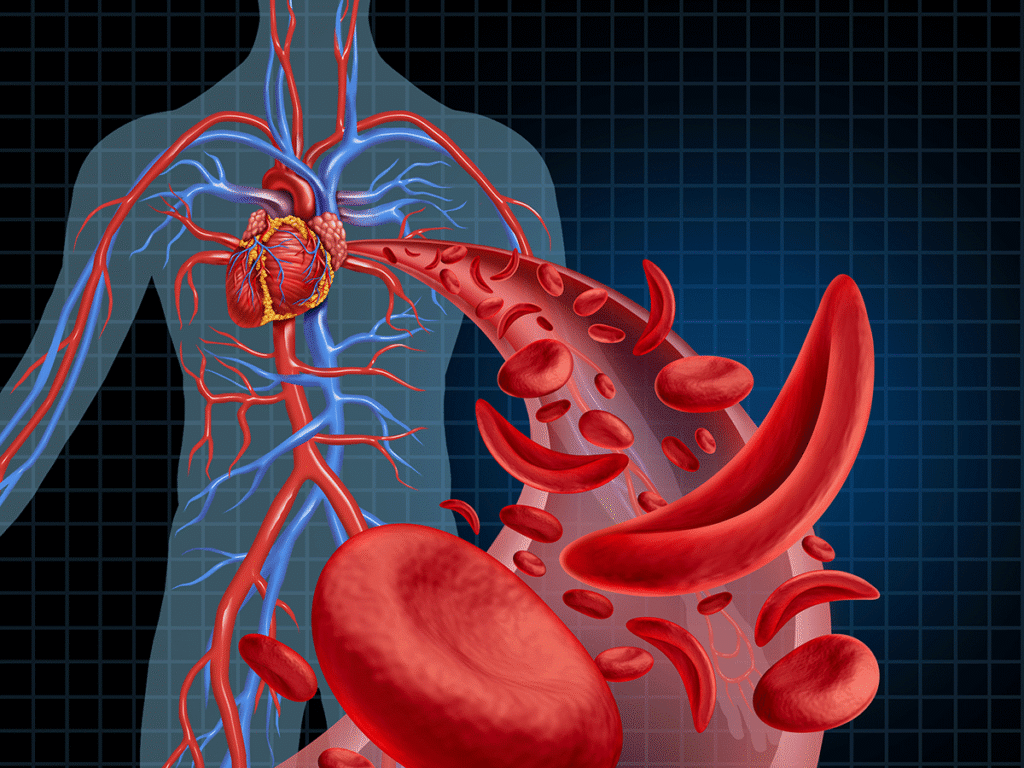What is Sickle Cell Disease?
Sickle Cell Disease (SCD) is a genetic blood disorder characterized by the production of abnormal hemoglobin, known as hemoglobin S. This causes red blood cells to become rigid, sticky, and shaped like a crescent or sickle, instead of the normal round shape. These misshapen cells can get stuck in small blood vessels, leading to various complications, including pain crises, infections, and organ damage.

Causes of Sickle Cell Disease
Sickle cell disease is inherited in an autosomal recessive pattern, meaning a person needs to inherit two copies of the sickle cell gene (one from each parent) to have the disease. If they inherit only one copy, they will have sickle cell trait, which typically does not cause symptoms but can pass the gene to their offspring.
The sickle cell gene is most prevalent among people of African, Mediterranean, Middle Eastern, and Indian ancestry. The presence of this gene is believed to have provided a survival advantage against malaria, which explains its frequency in regions where malaria is endemic.
Symptoms and Complications
Symptoms of sickle cell disease usually begin in early childhood and may include:
Anemia: Due to the rapid breakdown of sickle cells, leading to fatigue and weakness.
Pain Crises: Sudden episodes of severe pain, known as vaso-occlusive crises, occur when sickle-shaped cells block blood flow.
Frequent Infections: Sickle cells can damage the spleen, increasing susceptibility to infections.
Delayed Growth: Children with SCD may grow more slowly than their peers.
Vision Problems: Blockages in blood vessels can lead to vision issues.
Complications can include stroke, acute chest syndrome, and organ damage, making management of the disease critical.
Treatment Options
While there is currently no universal cure for sickle cell disease, various treatments can help manage symptoms and reduce complications:
1. Pain Management
Over-the-counter pain relievers, prescription medications, and, in severe cases, opioids may be used to manage pain during crises.
2. Hydroxyurea
This medication can help reduce the frequency of pain episodes and the need for blood transfusions by stimulating the production of fetal hemoglobin, which prevents sickling.
3. Blood Transfusions
Regular blood transfusions can help reduce anemia and lower the risk of stroke, particularly in children with severe disease.
4. Bone Marrow Transplantation
Currently, the only potential cure for sickle cell disease is a bone marrow or stem cell transplant. This procedure is most effective when performed in children with a compatible donor. However, it carries significant risks and is not suitable for all patients.
5. Gene Therapy
Emerging treatments, including gene therapy, aim to correct the genetic defect responsible for sickle cell disease. Clinical trials are ongoing, and early results show promise.
6. Preventive Care
Vaccinations and antibiotics are crucial for preventing infections, particularly in children with SCD. Regular health check-ups and screenings can help manage potential complications early.
Living with Sickle Cell Disease
Living with sickle cell disease requires a comprehensive care plan that includes regular medical check-ups, mental health support, and lifestyle adjustments. Patients are encouraged to stay hydrated, maintain a healthy diet, manage stress, and avoid extreme temperatures.
Support from family, friends, and the community plays a vital role in improving the quality of life for individuals with SCD. Awareness and education about the disease are essential for reducing stigma and ensuring that patients receive the support they need.
Sickle Cell Day Message
As we observe World Sickle Cell Day, let us stand together in solidarity with those affected by this condition. It is a day to raise awareness, educate our communities, and advocate for better treatments and support for individuals living with sickle cell disease.
To all individuals with sickle cell disease: You are not alone. Your strength and resilience inspire us all. Together, we can work towards a future where sickle cell disease is better understood, effectively managed, and ultimately cured. Let’s commit to supporting research, improving access to care, and fostering a compassionate community for everyone affected by SCD.
Sickle cell disease is a complex condition that requires ongoing research, treatment advancements, and community support. By increasing awareness and understanding, we can improve the lives of those affected and strive for a world free of the challenges posed by this disease.
Also read :

Allegations of Poison Incident Involving 16-Year-Old Student-VPAC Demands Investigation
![]()





